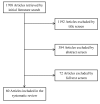Patient expectations and patient-reported outcomes in surgery: a systematic review
- PMID: 24787107
- PMCID: PMC4170731
- DOI: 10.1016/j.surg.2013.12.015
Patient expectations and patient-reported outcomes in surgery: a systematic review
Abstract
Background: Recent events in health care reform have brought national attention to integrating patient experiences and expectations into quality metrics. Few studies have comprehensively evaluated the effect of patient expectations on patient-reported outcomes (PROs) after surgery. The purpose of this study is to systematically review the available literature describing the relationship between patient expectations and postoperative PROs.
Methods: We performed a search of the literature published before November 1, 2012. Articles were included in the review if (1) primary data were presented, (2) patient expectations regarding a surgical procedure were measured, (3) PROs were measured, and (4) the relationship between patient expectations and PROs was specifically examined. PROs were categorized into 5 subgroups: Satisfaction, quality of life (QOL), disability, mood disorder, and pain. We examined each study to determine the relationship between patient expectations and PROs as well as study quality.
Results: From the initial literature search yielding 1,708 studies, 60 articles were included. Fulfillment of expectations was associated with improved PROs among 24 studies. Positive expectations were correlated with improved PROs for 28 studies (47%), and poorer PROs for 9 studies (15%). Eighteen studies reported that fulfillment of expectations was correlated with improved patient satisfaction, and 10 studies identified that positive expectations were correlated with improved postoperative. Finally, patients with positive preoperative expectations reported less pain (8 studies) and disability (15 studies) compared with patients with negative preoperative expectations.
Conclusion: Patient expectations are inconsistently correlated with PROs after surgery, and there is no accepted method to capture perioperative expectations. Future efforts to rigorously measure expectations and explore their influence on postoperative outcomes can inform clinicians and policymakers seeking to integrate PROs into measures of surgical quality.
Copyright © 2014. Published by Mosby, Inc.
Figures




Comment in
-
Evidence appraisal of Waljee J, McGlinn EP, Sears ED, Chung KC. Patient expectations and patient-reported outcomes in surgery: a systematic review: Surgery. 2014;155(5):799-808.AORN J. 2016 Feb;103(2):250-5. doi: 10.1016/j.aorn.2015.12.019. AORN J. 2016. PMID: 27263134 No abstract available.
References
-
- Institute of Medicine (U.S.) Crossing the quality chasm : a new health system for the 21st century. National Academy Press; Washington, D.C.: 2001. Committee on Quality of Health Care in America. - PubMed
-
- Prioritization IoMCoCER . Initial National Priorities for Comparative Effectiveness Research. The National Academies Press; Washington, D.C.: 2009.
-
- Kohn LT, Corrigan J, Donaldson MS, Institute of Medicine (U.S.) To err is human building a safer health system. National Academy Press; Washington, D.C.: 1999. Committee on Quality of Health Care in America. http://www.nap.edu/books/0309068371/html/ - PubMed
-
- Birkmeyer JD, Siewers AE, Finlayson EV, et al. Hospital volume and surgical mortality in the United States. N Engl J Med. 2002 Apr 11;346(15):1128–1137. - PubMed
Publication types
MeSH terms
Grants and funding
LinkOut - more resources
Full Text Sources
Other Literature Sources
Medical
Miscellaneous

